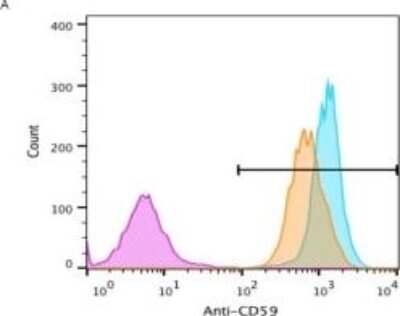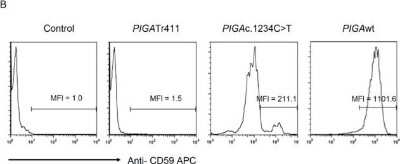CD59 Antibody (MEM-43/5) [Allophycocyanin]
Novus Biologicals, part of Bio-Techne | Catalog # NB500-400APC
Clone MEM-43/5 was used by HLDA to establish CD designation.


Conjugate
Catalog #
Forumulation
Catalog #
Key Product Details
Species Reactivity
Validated:
Human, Mouse
Cited:
Human
Applications
Validated:
CyTOF-ready, Flow Cytometry, Immunohistochemistry, Immunohistochemistry-Paraffin, Immunoprecipitation, Western Blot
Cited:
Flow Cytometry
Label
Allophycocyanin (Excitation = 620-650 nm, Emission = 660-670 nm)
Antibody Source
Monoclonal Mouse IgG2B Clone # MEM-43/5
Concentration
Please see the vial label for concentration. If unlisted please contact technical services.
Product Specifications
Immunogen
Thymocytes and T lymphocytes.
Reactivity Notes
Please note that this antibody is reactive to Mouse and derived from the same host, Mouse. Mouse-On-Mouse blocking reagent may be needed for IHC and ICC experiments to reduce high background signal. You can find these reagents under catalog numbers PK-2200-NB and MP-2400-NB. Please contact Technical Support if you have any questions.
Specificity
The antibody MEM-43/5 reacts with well defined epitope (around L33) on CD59 (Protectin), a 18-20 kDa glycosylphosphatidylinositol (GPI)-anchored glycoprotein expressed on all hematopoietic cells; it is widely present on cells in all tissues. The MEM-43/5 does not compete with most other CD59 antibodies. HLDA V; WS Code AS S012
Clonality
Monoclonal
Host
Mouse
Isotype
IgG2B
Scientific Data Images for CD59 Antibody (MEM-43/5) [Allophycocyanin]
Flow Cytometry: CD59 Antibody (MEM-43/5) [Allophycocyanin] [NB500-400APC] - The PIGAc.1234C>T mutation increases PIGA function compared to PIGAnull hiPSCs.(A). Representative example of FACS analysis CD59 expression in the three hiPSC lines. Overlay histogram shows that CD59 expression was significantly higher in PIGAc.1234 C>T hiPSCs compared to PIGAnull hiPSCs. MFI was 445.4 in PIGAwt hiPSCs and 332.6 in PIGAc.1234C>T hiPSCs (p>0.05, NS). However, MFI in PIGAc.1234C>T hiPSCs was significantly higher than 17.9 in PIGAnull hiPSCs (*p<0.05). The results indicated PIGA gene function was partially restored in PIGAc.1234C>T hiPSCs. PIGAnull hiPSCs (purple), PIGAc.1234C>T hiPSCs (orange) and PIGAwt hiPSCs (blue). Image collected and cropped by CiteAb from the following publication (https://dx.plos.org/10.1371/journal.pone.0174074), licensed under a CC-BY license.
Flow Cytometry: CD59 Antibody (MEM-43/5) [Allophycocyanin] [NB500-400APC] - Generation of PIGAc.1234C>T mutation using the PiggyBac transposon system. Representative FACS analysis CD59 expression in TF1PIGAnull cells transfected with PB-PIGAwt, PB-PIGAc.1234C>T or PB-PIGAtr411. Transfected TF1PIGAnull cells were stained with an APC-conjugated CD59 antibody to assess PIGA gene expression. Non-transfected TF1PIGAnull cells were used as a control. MFI represents mean fluorescence intensity. Image collected and cropped by CiteAb from the following publication (https://dx.plos.org/10.1371/journal.pone.0174074), licensed under a CC-BY license.
Flow Cytometry: CD59 Antibody (MEM-43/5) [Allophycocyanin] [NB500-400APC] - The PIGAc.1234C>T mutation does not impair terminal hematopoietic differentiation during mesoderm induction. Representative example of FACS analysis of hematopoietic phenotypes in the EB-BLCs from PIGAwt and PIGAc.1234C>T. The zebra plot shows expression of CD59 (X-axis) and CD45 (Y-axis) after three and eight days of hematopoietic differentiation. Unstained PIGAwt cells were used as a control. Abbreviations: CFU-Macrophage (M); CFU-Granulocyte-Macrophage (GM); committed erythroid BFU-E (BFU) and CFU-E (CFU) progenitors; multipotent progenitor cells CFU-GEMM (GEMM). Image collected and cropped by CiteAb from the following publication (https://dx.plos.org/10.1371/journal.pone.0174074), licensed under a CC-BY license.
Applications for CD59 Antibody (MEM-43/5) [Allophycocyanin]
Application
Recommended Usage
CyTOF-ready
Optimal dilutions of this antibody should be experimentally determined.
Flow Cytometry
Optimal dilutions of this antibody should be experimentally determined.
Immunohistochemistry
Optimal dilutions of this antibody should be experimentally determined.
Immunohistochemistry-Paraffin
Optimal dilutions of this antibody should be experimentally determined.
Immunoprecipitation
Optimal dilutions of this antibody should be experimentally determined.
Western Blot
Optimal dilutions of this antibody should be experimentally determined.
Formulation, Preparation, and Storage
Purification
Protein A purified
Formulation
PBS
Preservative
0.05% Sodium Azide
Concentration
Please see the vial label for concentration. If unlisted please contact technical services.
Shipping
The product is shipped with polar packs. Upon receipt, store it immediately at the temperature recommended below.
Stability & Storage
Store at 4C in the dark.
Background: CD59
Alternate Names
CD59, HRF20, MACIF, MIC11, Protectin
Gene Symbol
CD59
Additional CD59 Products
Product Documents for CD59 Antibody (MEM-43/5) [Allophycocyanin]
Product Specific Notices for CD59 Antibody (MEM-43/5) [Allophycocyanin]
This product is for research use only and is not approved for use in humans or in clinical diagnosis. Primary Antibodies are guaranteed for 1 year from date of receipt.
